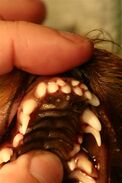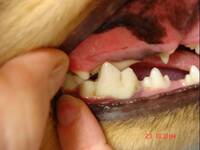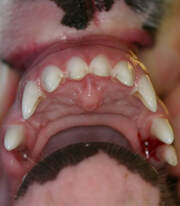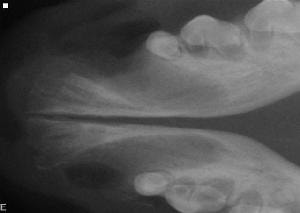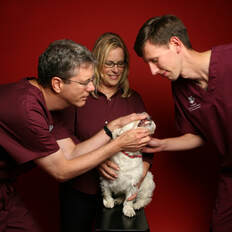Canine Dentistry and How to Look After My Dog's Teeth
For best viewing, please view on "Web" or Desktop settings. The mobile view sometimes doesn't show up correctly. Sorry!
What does a correct bite look like?
An Adult dog normally has 42 teeth, while puppies have 28 teeth. Some smaller toy breeds may not have every tooth erupt and often need more in the way of dental care due to their smaller nature. This tiny space is often crowded and it is easy for teeth to grow in imperfectly and over time have more problems with plaque.
A normal bite, and the most desirable in many (not all) breeds is called a "Scissors Bite". The "scissors bite" refers to the normal relationship between the upper and lower teeth. This is also called the normal occlusion. The upper incisors overlap the lower incisors when the mouth is closed (top photo). The lower incisor crown tips rest on the inside cingulum of the opposing upper incisor teeth. The lower canine teeth fit in between the upper third incisor and the upper canine without touching either of them with the mouth closed. In viewing the teeth from the side with the mouth closed, the premolar teeth of the upper and lower dental arcades interdigitate very much like the teeth of a "sheers scissors". Additionally; the upper fourth premolar tooth, overlaps the lower first molar tooth. These teeth function to tear food apart when chewing. These teeth are frequently referred to as carnasial (canine) teeth and are often injured (fractured) when very hard objects are chewed by dogs. We recommend prevention of chewing hard objects in an attempt to avoid fractured teeth!
My Puppy's Mouth Looks Like A Shark !!
The transition time between puppy and adult teeth can be troublesome and must be monitored carefully so that retained baby teeth can be removed before they cause bite issues. It is not unusual for a toy breed puppy to retain baby teeth as their adult teeth come in simultaneously. The problem is when the retained baby teeth do not fall out on their own and begin to affect the proper placement of the adult teeth. If not rectified, this can permanently cause minor or major malocclusions that may be potentially painful for the dog. The primary teeth need to be removed immediately in an attempt to avoid the development of malocclusions! To perform these procedures appropriately, dental radiographs are required.
During this transition period, the dentition is called a "mixed dentition". Do not panic if you see some doubling up for a short period of time. These teeth will quite often fall out on their own. Increase the amount of chew toys (that are safe) that will help loosen the baby teeth. Avoid the use of weight bearing bones (leg bones) as they are much denser and more likely to cause chipped or fractured teeth. Softer RAW bones (not cooked, or they become brittle and can splinter thus risking damage), are helpful. Sheep and goats bones tend to be a good choice (you can get away with some legs on these). Ribs such as Elk, Bison are also popular choices. Just make sure that anything your dog has in its mouth is monitored and taken away if it does start to break apart or get too small. Even with toy dogs, we do not buy the really tiny bones because they too easily and quickly become small enough to be hazardous or more likely to break off dangerous shards. A harder good quality food is also helpful both with the removal of primary teeth and with keeping teeth clean. Alternatively, a raw diet that includes some ground bone. Note that a kibble, if not quality, can actually increase the amount of tarter that is collected.
The puppy should largely have all its adult teeth in by between 8-10 months. This is a very important time to make sure that they are growing in properly. Quite often, this is often when a pet goes in for a spay or neuter, and that is a good time to also have any retained teeth pulled while they are already under the anesthetic. It is always a good idea to have radiographs done to make sure that there are no roots or other harder to see problems still there. If it is noticed that primary teeth are affecting the way the adult teeth are coming in, do not wait to have them removed. If in doubt, ask your veterinarian's advice.
During this transition period, the dentition is called a "mixed dentition". Do not panic if you see some doubling up for a short period of time. These teeth will quite often fall out on their own. Increase the amount of chew toys (that are safe) that will help loosen the baby teeth. Avoid the use of weight bearing bones (leg bones) as they are much denser and more likely to cause chipped or fractured teeth. Softer RAW bones (not cooked, or they become brittle and can splinter thus risking damage), are helpful. Sheep and goats bones tend to be a good choice (you can get away with some legs on these). Ribs such as Elk, Bison are also popular choices. Just make sure that anything your dog has in its mouth is monitored and taken away if it does start to break apart or get too small. Even with toy dogs, we do not buy the really tiny bones because they too easily and quickly become small enough to be hazardous or more likely to break off dangerous shards. A harder good quality food is also helpful both with the removal of primary teeth and with keeping teeth clean. Alternatively, a raw diet that includes some ground bone. Note that a kibble, if not quality, can actually increase the amount of tarter that is collected.
The puppy should largely have all its adult teeth in by between 8-10 months. This is a very important time to make sure that they are growing in properly. Quite often, this is often when a pet goes in for a spay or neuter, and that is a good time to also have any retained teeth pulled while they are already under the anesthetic. It is always a good idea to have radiographs done to make sure that there are no roots or other harder to see problems still there. If it is noticed that primary teeth are affecting the way the adult teeth are coming in, do not wait to have them removed. If in doubt, ask your veterinarian's advice.
What is a Malocclusion?
Malocclusion's are variations of the bite from the above described normal scissors bite. Malocclusion's are classified based on the dental relationships.
They are numbered one through three, with a fourth group that does not fit the first three. They are designated "Mal 1", "Mal 2" and "Mal 3".
They are numbered one through three, with a fourth group that does not fit the first three. They are designated "Mal 1", "Mal 2" and "Mal 3".
Top four photos credited to: Animal Dentistry and Oral Surgery Specialists LLC
Dental Care
Research shows that periodontal disease is one of the most prevalent problems with our companion animals. Dogs CAN get cavities and it can lead to structural damage, infection in the tooth and surrounding areas, premature death of the tooth, even widespread infection throughout the body. Newer studies even show that like in people, bacterial growth and infection in the mouth can be detrimental to heart and vascular health.
Simple observations can be helpful in diagnosing dental health.
- Check if one side of the mouth has more tarter and build up than the other, is there redness or swelling of the gums or the cheeks?
- Do the gums themselves look healthy and pink, or are they angry and red above the teeth? Dogs can get gingivitis just like we can, and it can lead to dental disease and discomfort. Do you notice any abnormalities in the color of the tissues in the mouth?
- Do you see any spots that look irritated (can indicate a bite issue, for example).
- Are there any teeth that rub on each other to the extent of changing the opposing tooth?
- Does the dog react as if in pain in any particular areas?
- Is he comfortable chewing on both sides?
- Does he drop a lot of food, or eat very gingerly as if it hurts?
- How is his breath? If it smells like something died in there, there is a good chance of some dental disease. Having clean teeth makes a world of difference.
Top three photos credited to: Animal Dentistry and Oral Surgery Specialists LLC
The Professional Cleaning
Pomeranians are especially prone to dental issues, as are most toy breed dogs. The smaller the mouth, generally the bigger the issues. Dental work is one of the biggest expenses an owner will need to commit to for the lifetime of their small companion. Many dogs require teeth to be pulled as they get older. Even with the best of care, some teeth just won't make it.
When you take your dog to the vet for a dental exam, make sure that the vet has been well familiarized with dental procedures, as many vets only come out of school with a fairly basic understanding. A vet who has either longer experience, or further training can be invaluable as they may save some teeth that a lesser experienced vet may pull, or it can go the other way when a tooth should be extracted.
One of the clues to finding a vet is to see if they are able to perform dental xrays at their location. This is so important, because a dog can have beautiful teeth on the outside appearance and then on xray, it can be found that those teeth have terrible roots, jawbone issues or problems under the gumline that cannot be seen with the naked eye.
Although many of our preventative procedures can help put off the "big dental" cleaning that the vet will do, there is no way around it - eventually they will need to have one. They need to be put under full anaesthetic in order to really be able to safely examine the full mouth and all the teeth. There just is no way to get the thorough cleaning without this. The vet will likely explain about how they use the ultrasonic machine (also known as a Cavitron, and it is largely the same as what we use in people). This is a great tool and especially safe while the dog is asleep. The machine requires a constant supply of water to keep the tip cool as the vibration between it and the tooth can be very dangerous if it is allowed to get hot. The ultrasonic machine will easily remove years of plaque and tarter and can safely get under the gumline without trauma while the dog is asleep. This is an important part to keeping the teeth healthy. The vet may also use some manual tools to get into specific or abnormally shaped areas of the teeth. The last procedure the vet will do is use a polisher to finish the teeth. Even the best tools used to clean the teeth can leave tiny, usually microscopic scratches in the enamel of the teeth. This can be an invitation to bacteria, and so while the dog is still asleep, they have their teeth polished (just like we do at the dentist)! It is then thoroughly rinsed and the dog will have a new lease on life with his pearly white teeth and hopefully any problem teeth now fixed or extracted and his breath will improve dramatically.
When you take your dog to the vet for a dental exam, make sure that the vet has been well familiarized with dental procedures, as many vets only come out of school with a fairly basic understanding. A vet who has either longer experience, or further training can be invaluable as they may save some teeth that a lesser experienced vet may pull, or it can go the other way when a tooth should be extracted.
One of the clues to finding a vet is to see if they are able to perform dental xrays at their location. This is so important, because a dog can have beautiful teeth on the outside appearance and then on xray, it can be found that those teeth have terrible roots, jawbone issues or problems under the gumline that cannot be seen with the naked eye.
Although many of our preventative procedures can help put off the "big dental" cleaning that the vet will do, there is no way around it - eventually they will need to have one. They need to be put under full anaesthetic in order to really be able to safely examine the full mouth and all the teeth. There just is no way to get the thorough cleaning without this. The vet will likely explain about how they use the ultrasonic machine (also known as a Cavitron, and it is largely the same as what we use in people). This is a great tool and especially safe while the dog is asleep. The machine requires a constant supply of water to keep the tip cool as the vibration between it and the tooth can be very dangerous if it is allowed to get hot. The ultrasonic machine will easily remove years of plaque and tarter and can safely get under the gumline without trauma while the dog is asleep. This is an important part to keeping the teeth healthy. The vet may also use some manual tools to get into specific or abnormally shaped areas of the teeth. The last procedure the vet will do is use a polisher to finish the teeth. Even the best tools used to clean the teeth can leave tiny, usually microscopic scratches in the enamel of the teeth. This can be an invitation to bacteria, and so while the dog is still asleep, they have their teeth polished (just like we do at the dentist)! It is then thoroughly rinsed and the dog will have a new lease on life with his pearly white teeth and hopefully any problem teeth now fixed or extracted and his breath will improve dramatically.
At Home Preventative Care
What can I do on my own to help my dog's dental health?
It is recommended by dental professionals to brush your dogs teeth twice a day with an enzymatic pet toothpaste. Make sure it is specifically made for pets, as others can be dangerous to the health of your animal. If you cannot do it that often, even brushing once every two days has value. However, less often than that makes the value almost nil.
A word of caution on dental treats. They are advertised a lot these days and sound like a wonderful thing. They are supposed to taste delicious and will keep the dog happily occupied for quite a while, all the while cleaning the teeth and causing fresh minty breath. Unfortunately this all too often turns into a sad story...Many of the dental treats out there simply do not break down in a safe way for consumption. They are meant to be hard, to try to make the dog work it more on it's teeth so that they can claim the benefits of tooth cleaning. The dark side of this is that being that hard and breaking down that slowly can so easily cause choke when an over excited pooch tries to inevitably wolf down his treat too quickly or gets competitive with another pack member. If you are lucky, and the dog is able to chew it down and it reaches the stomach, then there is the risk of intestinal blockage because it continues to break down at a rate slower than what it is being passed thru. There are a few dental treats that are softer, but then they generally are of little value as far as actually cleaning the teeth.
Bones
If selected carefully, a bone can be a wonderful thing for cleaning teeth and providing stimulation for the dog. Having said this, vets have had many a dog enter the office with blockage or worse, intestinal rupture if a bad, sharp piece of bone is consumed and swallowed as a shard. Ways to prevent this are to purchase only raw bones, and selecting bones of a size that the dog cannot easily just crunch apart or small enough that they can swallow largely whole. Get something that is big enough that they will need to work at it. And of course, supervise your animal! Occasionally, even a good bone can splinter.
For smaller dogs especially, avoid buying large weight bearing bones like tibias or "Dino bones". This is because they will try so hard to chew on it, and this is a denser bone than what their teeth are, so they risk fractured or chipped teeth (which can be painful and expensive to repair). A good choice is often large ribs bones (the angles are great for them to work their teeth against), or if it is a bone from a sheep or a goat (then they can have just about any of the bones of the appropriate size).
Bone as part of a raw diet, mashed up into a paste can also have some benefit to the teeth because of the little sand like particles that will grind against the teeth as they consume it.
Pet Store Bones - Be super cautious with the bones most commonly found at the pet store. These are all too often baked or cured/smoked and this takes a lot of the nutritional benefit out of the bone, but what is worse is that it causes the bone to become brittle and easily have dangerous, sharp pieces break off. These are what can cause the most damage with high risk of intestinal damage. Many of these bones are also the heavy weight bearing bones, so carry that risk as well.
Plastic Bones and Commercially Produced Bones - These have gotten a little better over the years, but most dogs really have little interest in chewing something that smells like plastic or rubber. Some of the flavour infused ones can be more convincing. Either way, be sure to carefully check the packaging and see if it says that it is safe for the dog to consume. Most do not, which is ironic being that the bone was created for chewing, and yet they say dangerous to eat because it doesn't break down in the digestive tract.
It is recommended by dental professionals to brush your dogs teeth twice a day with an enzymatic pet toothpaste. Make sure it is specifically made for pets, as others can be dangerous to the health of your animal. If you cannot do it that often, even brushing once every two days has value. However, less often than that makes the value almost nil.
A word of caution on dental treats. They are advertised a lot these days and sound like a wonderful thing. They are supposed to taste delicious and will keep the dog happily occupied for quite a while, all the while cleaning the teeth and causing fresh minty breath. Unfortunately this all too often turns into a sad story...Many of the dental treats out there simply do not break down in a safe way for consumption. They are meant to be hard, to try to make the dog work it more on it's teeth so that they can claim the benefits of tooth cleaning. The dark side of this is that being that hard and breaking down that slowly can so easily cause choke when an over excited pooch tries to inevitably wolf down his treat too quickly or gets competitive with another pack member. If you are lucky, and the dog is able to chew it down and it reaches the stomach, then there is the risk of intestinal blockage because it continues to break down at a rate slower than what it is being passed thru. There are a few dental treats that are softer, but then they generally are of little value as far as actually cleaning the teeth.
Bones
If selected carefully, a bone can be a wonderful thing for cleaning teeth and providing stimulation for the dog. Having said this, vets have had many a dog enter the office with blockage or worse, intestinal rupture if a bad, sharp piece of bone is consumed and swallowed as a shard. Ways to prevent this are to purchase only raw bones, and selecting bones of a size that the dog cannot easily just crunch apart or small enough that they can swallow largely whole. Get something that is big enough that they will need to work at it. And of course, supervise your animal! Occasionally, even a good bone can splinter.
For smaller dogs especially, avoid buying large weight bearing bones like tibias or "Dino bones". This is because they will try so hard to chew on it, and this is a denser bone than what their teeth are, so they risk fractured or chipped teeth (which can be painful and expensive to repair). A good choice is often large ribs bones (the angles are great for them to work their teeth against), or if it is a bone from a sheep or a goat (then they can have just about any of the bones of the appropriate size).
Bone as part of a raw diet, mashed up into a paste can also have some benefit to the teeth because of the little sand like particles that will grind against the teeth as they consume it.
Pet Store Bones - Be super cautious with the bones most commonly found at the pet store. These are all too often baked or cured/smoked and this takes a lot of the nutritional benefit out of the bone, but what is worse is that it causes the bone to become brittle and easily have dangerous, sharp pieces break off. These are what can cause the most damage with high risk of intestinal damage. Many of these bones are also the heavy weight bearing bones, so carry that risk as well.
Plastic Bones and Commercially Produced Bones - These have gotten a little better over the years, but most dogs really have little interest in chewing something that smells like plastic or rubber. Some of the flavour infused ones can be more convincing. Either way, be sure to carefully check the packaging and see if it says that it is safe for the dog to consume. Most do not, which is ironic being that the bone was created for chewing, and yet they say dangerous to eat because it doesn't break down in the digestive tract.
Anesthesia Free Cleaning
Although I personally advocate for some people to use or do some limited dental services for their own pets, it must be mentioned that there are some risks involved also.
The Pros:
1. Patient motion prevents adequate view of all of the teeth.
2. Teeth or dental surfaces you can't see, won't be cleaned adequately.
3. Inadequate cleaning will allow plaque bacteria to cause periodontal disease.
Risks of Anesthesia Free Pet Dental Cleaning:
1. Patient motion can cause oral injury during teeth scaling procedures.
2. Patient motion will not allow for dental radiographs to be taken adequately.
3. Patient motion may cause pet pain if periodontal probing is performed.
4. Inability to see may cause misdiagnosis, or failure to diagnose any problems.
5. Dental calculus (tartar) may fall into the pet's respiratory tract, and cause severe disease or even death.
6. Owners may be led to believe their pet is healthy, while severe disease may be present.
The Pros:
- It may be possible to keep the pet's teeth in a better state, more regularly than if they were only seeing the vet for maintenance.
- If a person is unable to brush their dogs teeth or the dog is not a big chewer, it does help to keep the visible calculus and plaque down and therefore help somewhat in the fight against gingivitis and other problems.
- It is also a way to notice what could be a problem early and be able to follow up more thoroughly with a vet if it is spotted.
- Being a toy breed, there are a lot more risks involved with putting a dog under anesthetic. This is a way to reduce the number of times they have to go under.
- If the person doing the procedure is experienced, and especially if they have a relationship with the dog, some of the risk factors are far lessened and this can allow a dog who may not have the option of going under anesthesia to still have at least some dental care.
1. Patient motion prevents adequate view of all of the teeth.
2. Teeth or dental surfaces you can't see, won't be cleaned adequately.
3. Inadequate cleaning will allow plaque bacteria to cause periodontal disease.
Risks of Anesthesia Free Pet Dental Cleaning:
1. Patient motion can cause oral injury during teeth scaling procedures.
2. Patient motion will not allow for dental radiographs to be taken adequately.
3. Patient motion may cause pet pain if periodontal probing is performed.
4. Inability to see may cause misdiagnosis, or failure to diagnose any problems.
5. Dental calculus (tartar) may fall into the pet's respiratory tract, and cause severe disease or even death.
6. Owners may be led to believe their pet is healthy, while severe disease may be present.
Conclusion
We hope that this article helped at least as a basic start to understand what is a correct bite, how to recognize common issues and some information on how to care for your pomeranian's teeth.
Many thanks to ANIMAL DENTISTRY AND ORAL SURGERY SPECIALIST LLC, From whom gets credit for much of the information on this article. Their website is very informative and contains many other articles of interest pertaining to animal dentistry for both dogs and other species. Some of the information in this article are direct quotes off of their articles, an appendices can be found below to direct those who are interested. It is my intention to give full credit to their source material and not confuse people with what is directly from the vet's mouth and what is contributed from other sources. My own personal experiences and information garnered from other breeders and those experienced in the field have been used to fill out the rest of the article.
We believe this is an important topic and often easily overlooked. If you have any feedback or would like to see anything added to this article, please feel free to message me!
Many thanks to ANIMAL DENTISTRY AND ORAL SURGERY SPECIALIST LLC, From whom gets credit for much of the information on this article. Their website is very informative and contains many other articles of interest pertaining to animal dentistry for both dogs and other species. Some of the information in this article are direct quotes off of their articles, an appendices can be found below to direct those who are interested. It is my intention to give full credit to their source material and not confuse people with what is directly from the vet's mouth and what is contributed from other sources. My own personal experiences and information garnered from other breeders and those experienced in the field have been used to fill out the rest of the article.
We believe this is an important topic and often easily overlooked. If you have any feedback or would like to see anything added to this article, please feel free to message me!
Article Credits:
Photo Credits as listed on captions.
Direct quotes from web pages from Animal Dentistry and Oral Surgery Specialist LLC can be located by their BLUE coloration.
Written and arranged by Lori Reinhardt 2020
Photo Credits as listed on captions.
Direct quotes from web pages from Animal Dentistry and Oral Surgery Specialist LLC can be located by their BLUE coloration.
Written and arranged by Lori Reinhardt 2020





